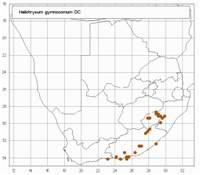Origin of name:
gymno- = naked
comum = hair of the head (Greek)
Diagnostic characters:
Yellow bracts
Compact flower heads on long stalks
Leaves spathulate, greyish, hairy with sharp tip
Description:
A much branched bushy or straggling aromatic perennial herb, stems often decumbent and rooting at the base and becoming woody there, erect or sprawling, glandular, generally thinly greyish-white woolly, wool sometimes wanting, very leafy, the branchlets becoming pedunculoid upwards with distant reduced leaves or bracts. Leaves very variable, 5�60 x 1.5�15 mm, linear-oblong, lanceolate, ungulate or spathulate, apex generally obtuse, sometimes acute, mucronate, base narrowed or broad, clasping, generally decurrent in long narrow or broad stem wings, wings sometimes wanting, glandular and setose-scabrid above, generally thinly or thickly greyish-white woolly on both surfaces, sometimes without wool or glabrescent above. Heads often homogamous, c. 3�4 mm long, very many matted together with wool at the base in dense or loose, flattened or rounded, terminal cymose clusters. Involucral bracts loosely imbricate, innermost about equaling the flowers, not radiating, pellucid, outer pale brown, inner bright or pale canary-yellow. Receptacle with fimbrils about equaling the ovaries. Flowers 4�7, (1�) 1 or 2 occasionally female, (2�) 5�11 homogamous, yellow. Achenes 0.75 mm, barrel-shaped, with duplex hairs. Pappus often wanting or consisting of a few bristles free at the base, but may be copious and cohering at the base in Cape material.
Flowering between February and July.
Distribution:
Found in KwaZulu-Natal between c. 1 500 and 3 000 m above sea level and ranging southwards to the Cape Coast as far west as the mouth of the Gouritz River. In KwaZulu-Natal, partly sympatric with H. odoratissimum but reaching higher altitudes than that species, although this is not so in Lesotho. Occupies the same sort of habitats as H. odoratissimum and flowers between February and July.
Grassland and Thicket Biomes.
Notes:
Very closely allied to H. odoratissimum, but distinguished by its heads, often homogamous, c. 3�4 mm long, involucral bracts loosely imbricate; flowers 4�7, 1 or 2 of these occasionally female, pappus often wanting or consisting of a few bristles free at the base, but may be copious and cohering at the base in Cape material.
Taxonomy:
Literature:
Helichrysum gymnocomum DC., Prodr. 6: 202 (1838); Harv. in F.C. 3: 244 (1865); Hilliard, Compositae in Natal 151 (1977).
Type:
Lectotype: Cape, between Bushman's and Gouritz Rivers, Burchell 4334 (G-DC; K, isolecto.).
Synonym(s):
Gnaphalium gymnocomum (DC.) Sch. Bip. in Bot. Ztg 3: 172 (1845).
H. gymnocomum var. acuminatum DC., Prodr. 6: 202 (1838). Type: Cape, between Van Staadensberg and Bethelsdorp, Dr�ge 59496 (G-DC, holo.; BM; E; PRE, iso.).
Vouchers:
Codd 2785 (NU; PRE); Esterhuysen 21695 (BOL; PRE); Hilliard 4802 (E; K; MO; NH; NU; S); West 812 (BM; PRE); Wright 550 (E; NH; NU; S).

